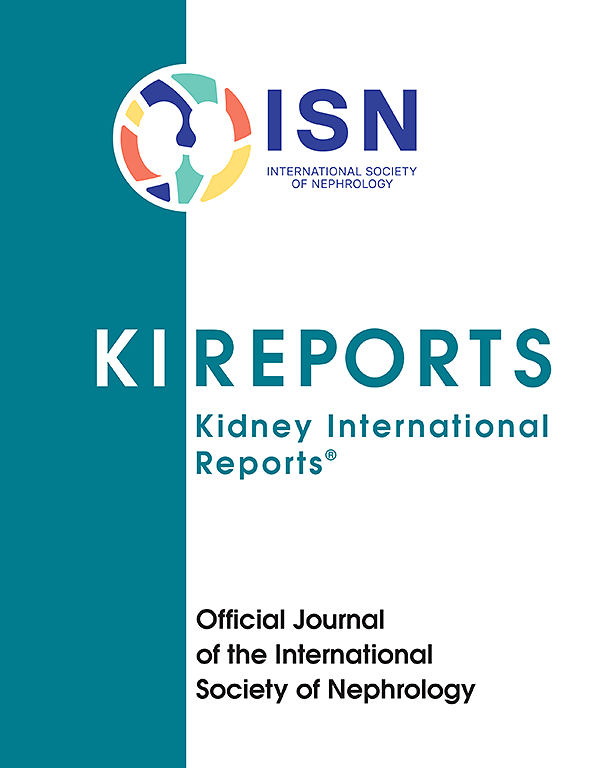Flow-Cytometric Quantification of Urine Kidney Epithelial Cells Specifically Reflects Tubular Damage in Acute Kidney Diseases
IF 5.7
2区 医学
Q1 UROLOGY & NEPHROLOGY
引用次数: 0
Abstract
Introduction
Tubular injury is one of the main mechanisms driving acute kidney injury (AKI); however, clinicians still have a limited diagnostic repertoire to precisely monitor damage to tubular epithelial cells (TECs). In our previous study, we used single-cell sequencing to identify TEC subsets as the main components of the urine signature of AKI. This study aimed to establish TECs as clinical markers of tubular damage.
Methods
A total of 243 patients were analyzed. For sequencing, we collected 8 urine samples from patients with AKI and glomerular disease. We developed a protocol for the flow cytometric quantification of CD10/CD13+ proximal TECs (PTECs) and CD227/CD326+ distal TECs (DTECs) in urine by aligning urinary single-cell transcriptomes and TEC surface proteins using Cellular Indexing of Transcriptome and Epitope Sequencing (CITE-Seq). Marker combinations were confirmed in kidney biopsies. We validated our approach in 4 cohorts of 235 patients as follows: patients with AKI (n = 63), COVID-19 infection (n = 47), antineutrophil cytoplasmic autoantibody (ANCA)–associated vasculitis (AAV) with active disease or stable remission (n = 110), and healthy controls (n = 15).
Results
Our findings demonstrated that CD10/CD13 and CD227/CD326 adequately identified PTECs and DTECs, respectively. Distal urinary TEC counts correlate with the severity of AKI based on Kidney Disease: Improving Global Outcomes (KDIGO) stage and acute estimated glomerular filtration rate (GFR) loss in 2 separate cohorts and can successfully discriminate AKI from healthy controls and glomerular disease.
Conclusion
We propose that urinary CD227/CD326+ TEC count is a specific, noninvasive marker for tubular injury in AKI. Our protocol provides a basis for a deeper phenotypic analysis of urinary TECs.

尿肾上皮细胞的流式细胞术定量特异性反映急性肾病小管损伤
肾小管损伤是急性肾损伤(AKI)的主要机制之一;然而,临床医生在精确监测小管上皮细胞(TECs)损伤方面的诊断能力仍然有限。在我们之前的研究中,我们使用单细胞测序来鉴定TEC亚群作为AKI尿液特征的主要组成部分。本研究旨在建立tec作为肾小管损伤的临床标志。方法对243例患者进行分析。为了测序,我们收集了8例AKI合并肾小球疾病患者的尿液样本。我们开发了一种流式细胞术定量尿液中CD10/CD13+近端TECs (PTECs)和CD227/CD326+远端TECs (DTECs)的方案,通过使用细胞转录组索引和表位测序(CITE-Seq)对尿单细胞转录组和TEC表面蛋白进行比对。肾活检证实了标志物组合。我们在4组235例患者中验证了我们的方法:AKI (n = 63)、COVID-19感染(n = 47)、疾病活动性或稳定缓解的抗中性粒细胞胞浆自身抗体(ANCA)相关血管炎(AAV)患者(n = 110)和健康对照组(n = 15)。结果CD10/CD13和CD227/CD326分别能够充分识别ptec和dtec。基于肾脏疾病的远端尿TEC计数与AKI的严重程度相关:改善总体结局(KDIGO)阶段和急性肾小球滤过率(GFR)损失在两个单独的队列中,可以成功地将AKI与健康对照和肾小球疾病区分开来。结论尿CD227/CD326+ TEC计数是AKI肾小管损伤的特异性、无创标志物。我们的方案为更深入的尿tec表型分析提供了基础。
本文章由计算机程序翻译,如有差异,请以英文原文为准。
求助全文
约1分钟内获得全文
求助全文
来源期刊

Kidney International Reports
Medicine-Nephrology
CiteScore
7.70
自引率
3.30%
发文量
1578
审稿时长
8 weeks
期刊介绍:
Kidney International Reports, an official journal of the International Society of Nephrology, is a peer-reviewed, open access journal devoted to the publication of leading research and developments related to kidney disease. With the primary aim of contributing to improved care of patients with kidney disease, the journal will publish original clinical and select translational articles and educational content related to the pathogenesis, evaluation and management of acute and chronic kidney disease, end stage renal disease (including transplantation), acid-base, fluid and electrolyte disturbances and hypertension. Of particular interest are submissions related to clinical trials, epidemiology, systematic reviews (including meta-analyses) and outcomes research. The journal will also provide a platform for wider dissemination of national and regional guidelines as well as consensus meeting reports.
 求助内容:
求助内容: 应助结果提醒方式:
应助结果提醒方式:


